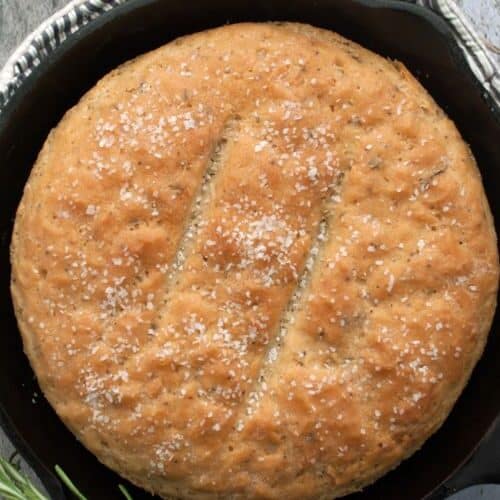
Gluten-Free Rosemary Olive Oil Bread
This Gluten-Free Rosemary Olive Oil Bread is a perfect option for those looking to enjoy a flavorful, soft, and aromatic loaf without gluten. Combining the rich taste of olive oil with the fragrant earthy notes of rosemary, this bread is not only gluten-free but also versatile enough to complement a variety of dishes. Whether served alongside a meal, used for sandwiches, or enjoyed as a snack, this bread is sure to be a favorite.
Equipment
- 1 large mixing bowl
- 1 Small Bowl (for yeast mixture)
- 1 loaf pan or baking sheet
- 1 kitchen towel (for covering dough)
- Measuring Cups and Spoons
- 1 Spatula or spoon for mixing
- Wire Rack (for cooling)
- 1 oven
- 1 knife (for scoring, optional)
Ingredients
- 2 ½ cups Gluten-Free Flour Blend
- 1 tablespoon Fresh Rosemary finely chopped
- ¼ cup Olive Oil
- 2 teaspoons Active Dry Yeast
- 1 tablespoon Honey or Sugar to activate yeast
- 1 ¼ cups Warm Water 110°F/43°C
- 1 teaspoon Salt
- 1 teaspoon Apple Cider Vinegar optional
- ½ teaspoon Garlic Powder optional
- ¼ cup Chopped Olives optional
Instructions
Activate the Yeast
- In a small bowl, combine the warm water, honey (or sugar), and active dry yeast. Stir gently and let it sit for 5-10 minutes until it becomes foamy.
Mix the Dough
- In a large bowl, combine the gluten-free flour blend, rosemary, salt, and garlic powder (if using). Create a well in the center and pour in the activated yeast mixture and olive oil. Stir until the dough begins to come together. Add more flour or water if needed to achieve a thick, sticky dough.
Knead and Rest
- Knead the dough lightly for a few minutes to ensure the ingredients are fully combined. Cover the bowl with a kitchen towel and allow the dough to rest in a warm area for 1-1.5 hours, or until it has risen slightly.
Shape the Dough
- Transfer the dough into a greased loaf pan or onto a parchment-lined baking sheet. Shape it into your desired loaf form.Optionally, score the top of the dough with a knife to create a decorative pattern.
Bake the Bread
- Preheat the oven to 375°F (190°C). Bake the bread for 30-40 minutes, or until it’s golden on top and sounds hollow when tapped. Remove the bread from the oven and let it cool on a wire rack before slicing.
Cool and Serve
- Allow the bread to cool completely before slicing. Serve warm with dips, spreads, or enjoy as a snack.
Notes
- Flour Blend: Be sure to use a high-quality gluten-free flour blend designed for baking, as it typically contains binding agents such as xanthan gum or guar gum that will help create the right texture.
- Storage: Store any leftover bread in an airtight container at room temperature for up to 3 days. For longer storage, slice and freeze individual pieces for later use.
- Flavor Additions: Feel free to add extra ingredients like olives, garlic, or even a touch of balsamic vinegar to enhance the flavor and make the bread your own.
- Yeast Activation: If your yeast doesn’t foam, it may be expired or the water temperature may have been too hot or too cold. Use a thermometer to ensure the water is around 110°F (43°C).